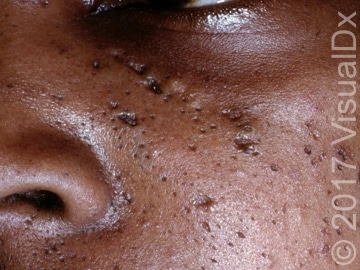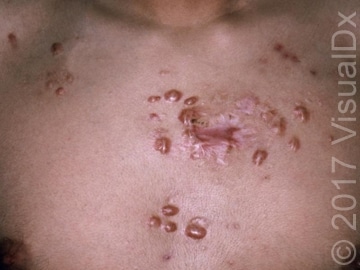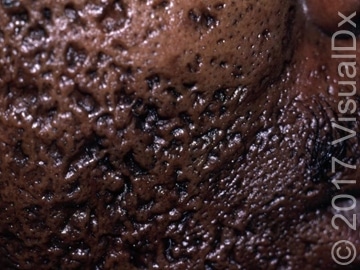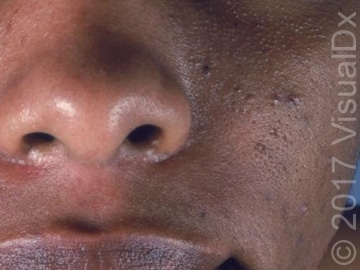Acne is one of the most common skin conditions worldwide. Up to 8 of 10 people between the ages of 11 and 30 summer from acne. Once of the most common and unfortunate side effects of acne is scarring. Long after acne goes away, the marks can still remain. As dermatologists, we certainly see a wide spectrum of acne scarring, from the very mild to severe. Each patient is affected differently by their scarring.
Currently, there are many existing treatments available to improve acne scarring. Some even exist as home therapies. We’ll review some options below.
What Causes Acne Scarring?
The obvious answer is acne, but it’s more complicated. Usually, the more severe the acne is, the more likely it is to scar. However, this isn’t an absolute rule. Everyone has a different likelihood to scar. Manipulation of acne can increase the risk of scarring in some individuals. Thus, a combination of severe acne and a higher likelihood of baseline scarring contribute to the final outcome.
Are All Acne Scars the Sames?
Acne scars can very in their appearance. Experts have attempted to classify acne scars based on their appearance to help guide treatment.1 The 3 forms of scars are:
- Rolling scars – These are the widest types of scars (4 mm or greater), and they are shallow in appearance. Instead of smooth skin, rolling scars look like hills and valleys on the skin. They can be represented as a sine symbol.

- Boxcar scars – These type of scars are smaller in width than rolling scars (2-4 mm) but appear deeper in the skin. They usually don’t taper significantly from the surface of the skin to the base of the skin.
- Icepick scars – These scars look like an icepick injury. They are basically tapered small acne scars that extend deep into the skin. They are the smallest in width.

Chemical Peels
There are various forms of chemical peels at different depths (eg, Jessner solution, trichloroacetic acid) that have been shown to improve acne scars depending on how deep your acne scars are. A special technique includes using trichloroacetic acid directly at the base to stimulate healthy skin formation. Typically, deeper acne scars require peels that work deeper. Chemical peels should be performed by a trained dermatologist given the risk of harm.
Surgical Techniques
Subcision: Subcision is a special form of skin surgery that is particularly effective for rolling acne scars. In this procedure, the scar tissue that runs underneath the skin is snipped. This helps release the normal skin to fill in any valleys caused by rolling scars. The procedure itself stimulates new, healthy collagen formation.
Punch techniques: Punch techniques involve simply using a tool that creates a new, slightly larger circular wound that removes the scar tissue. The surgeon will then suture the wound closed with the hope that the result wound will be better in cosmetic appearance. This can be very effective for both boxcar scars and icepick scars. For larger scars, a surgeon may even perform an elliptical excision.
Non-Invasive Medical Devices
Skin needling: Skin needling has recently come onto the scene. These dermaroller devices have needles varying in depth from 0.5 mm to 4 mm. They essentially create small micro-wounds in the skin that then stimulate healthy collagen formation. These devices are widely available to consumers online and can be very cost-effective. Bleeding and bruising are the most common side effects. We do recommend first consulting a dermatologist before treating acne scars on your own.
Light-Based Therapies: Photodynamic therapy (PDT) combines the use of a photosensitizing drug with activating blue light to improve the appearance of scarring. It is also an effective treatment for acne itself. For individuals who may not be good candidates for oral medications or have failed topical drugs, PDT may offer another treatment modality for both acne and scarring.
Injectables
Steroids: For keloid or hypertrophic acne scarring, the go-to treatment is intralesional steroid injections. These injections can help soften the s
cars and thin out their appearance.
Fillers: For deeper scars that simply won’t go away or for isolated scars that do not require a full treatment, injectable fillers are a good option. They help fill in the holes. Some fillers are permanent, while others require repeat treatments.
Note for Darkest Skin Types
Individuals with darker skin tones may not be good candidates for some procedures (particularly certain laser techniques). When injured, darker skin types tend to become even darker (post-inflammatory hyperpigmentation). This usually fades but can take many months.
Conclusion
Acne scarring can be disfiguring and bothersome to patients. Fortunately, there are many options out there currently. Although there is no complete cure, dermatologists are frequently able to significantly improve the appearance.
References
- Jacob Cl, Dover JS, Kaminer MS. Acne scarring: a classification system and review of treatment options. J Am Acad Dermatol. 2001;45(1):109-117. [PubMed]
Last modified on October 18th, 2018 at 6:45 pm

